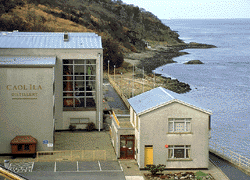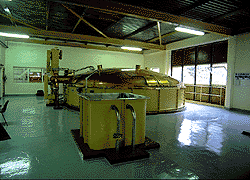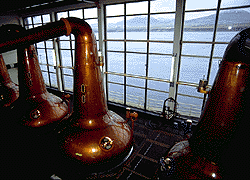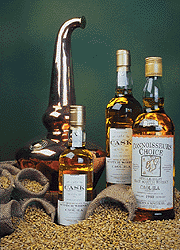
 Our roving reporters have wandered further afield for this issue, leaving the
mainland of Scotland by ferry to the island of Islay. The ferry journey, which
lasts two hours is a scenic one, passing the island of Gigha and on a clear day
Ireland is visible some 15 miles to the South West. As you enter the "Sound
of Islay" the ferry passes the sheer cliff faces of Islay to the left and
the towering Paps of Jura to the right. The ferry docks at the small quay at
Port Askaig, just a short drive from Caol Ila Distillery. The road to the
distillery drops steeply to reveal the distillery buildings nestling on the sea
shore.
Our roving reporters have wandered further afield for this issue, leaving the
mainland of Scotland by ferry to the island of Islay. The ferry journey, which
lasts two hours is a scenic one, passing the island of Gigha and on a clear day
Ireland is visible some 15 miles to the South West. As you enter the "Sound
of Islay" the ferry passes the sheer cliff faces of Islay to the left and
the towering Paps of Jura to the right. The ferry docks at the small quay at
Port Askaig, just a short drive from Caol Ila Distillery. The road to the
distillery drops steeply to reveal the distillery buildings nestling on the sea
shore.
We were fortunate to be shown round the distillery by Grant Carmichael, the general manager of Caol Ila and the company's sister distillery Lagavulin, situated on the South of the island. Shortly to retire he has been with the distillery for much of his working life; a friendly and most knowledgeable host. The next time we visit the distillery the manager will be Mike Nicolson.

The distillery site was originally used for lead ore washing because of the plentiful supply of water running from Loch nam Ban. When in early 1840 Hector Henderson started looking for a site for his new distillery, it was the plentiful supply of water and the tracks leading to this cove on the sea shore which drew him to the same spot.
The distillery was built in 1846 and he named it Caol Ila, the Gaelic for the "Sound of Islay" which the distillery overlooks. The burn runs down a steep hill to the distillery and this was used, not only for mashing and cooling at the distillery, but for generating power in the turbines.
In 1863 the distillery was acquired by Bulloch Lade & Co., owners of Loch Catrine Distillery in Glasgow. During their ownership, a pier was built in front of the distillery, designed to cope with the 12 feet rise and fall of the tide. This enabled small cargo ships called "puffers" to bring supplies of coal and barley direct to the distillery, with mature whisky as the return load to the mainland.
Bulloch Lade extended the distillery and by 1879, output had increased to 147,000 gallons per year. In 1920, the distillery was bought by a consortium of businessmen who formed the Caol Ila Distillery Co. Ltd. They made further improvements to increase efficiency.
In 1927, the Distillers Co. Ltd. acquired a controlling interest in the company and three years later their subsidiary Scottish Malt Distillers Ltd. (SMD) bought all the shares. SMD now trade as United Distillers and still own the distillery.
SMD bought their own "puffer" and named her Pibroch. She regularly sailed between the mainland and the distillery bringing supplies and returning with mature whisky, until she retired in 1972.
Caol Ila has always been sought after by blenders and in 1972 the distillery was closed so that extensive modernisation could be carried out and output increased to meet customers' requirements.
When in 1974 the distillery re-opened, the only original building to remain standing was the cask warehouse. The new buildings are of the classical 1970s style adopted for distilleries designed at the time and the distillery recently received an architectural award.
As befits the largest distillery on the island, two large boilers were installed to serve the increased capacity - some three million litres of alcohol per year. Six new stills were installed in place of two, each a replica of the old stills. The new layout meant that all equipment was of the optimum size to allow for efficiency. Push button control panels were installed but the skill of the distillery worker was still considered an essential part of the production process.
Although the distillery used to have its own floor maltings, all the malt now comes from the maltings at Port Ellen. Malt storage capacity is 250 tons and this is milled in a Porteus Mill that was in use before 1972. The traditional style mashtun, of 12 tons' capacity, was installed in 1973 and has recently been converted to a semi-lauter tun. This further improved efficiency without affecting quality.
The wash backs stand tall and hold 60,000 litres and due to their great height of 16 feet they are made of larch instead of the more traditional pine.
 The
stills are of traditional shape, the three wash stills of 20,000 litres each and
the three spirit stills of 14,000 each. The tall windows of the still room
overlook the Sound of Islay with Jura and the Paps of the Jura in the
background. Just a momentary glance reveals seals' heads bobbing up and down in
the water, small colourful fishing boats heading out from the distillery pier to
the lobster grounds, scaring the eider duck and cormorant perching on the rock
outcrops flapping to dry their wings.
The
stills are of traditional shape, the three wash stills of 20,000 litres each and
the three spirit stills of 14,000 each. The tall windows of the still room
overlook the Sound of Islay with Jura and the Paps of the Jura in the
background. Just a momentary glance reveals seals' heads bobbing up and down in
the water, small colourful fishing boats heading out from the distillery pier to
the lobster grounds, scaring the eider duck and cormorant perching on the rock
outcrops flapping to dry their wings.

Apart from the spectacular view, the proximity to the sea has many other benefits. Whilst the distillery water supply can cope with cooling requirements most of the year, an ingenious secondary condenser system uses sea water to cool burn water for recycling on hot summer days.
New whisky is stored in the large cask warehouse beside the distillery or on the mainland. Although the whisky produced is a traditional Islay malt, it is unusually light in body with a very smoky aftertaste.
When the distillery was built, houses were also constructed for workers on the hillside overlooking the distillery. This small community had its own shop and Mission Hall. Most of the houses still stand and most are used by distillery workers, some of whom are the third generation to work in the distillery.
Caol Ila is a medium malt, golden in colour, with a warming peaty, yet sweet flavour. It is available from Gordon & MacPhail under the Connoisseurs Choice label, distilled 1980 and also, at cask strength (dist. 1980 65.3%).
Caol Ila is also bottled by United Distillers as part of their "Flora and Fauna" Distillery Malts Range.
Try out a Recipe, which uses Connoisseurs Choice Caol Ila whisky and read our tasting notes for Caol Ila.
Return to News Archive
Home | History | Sample Room | News | Product Range | Shop